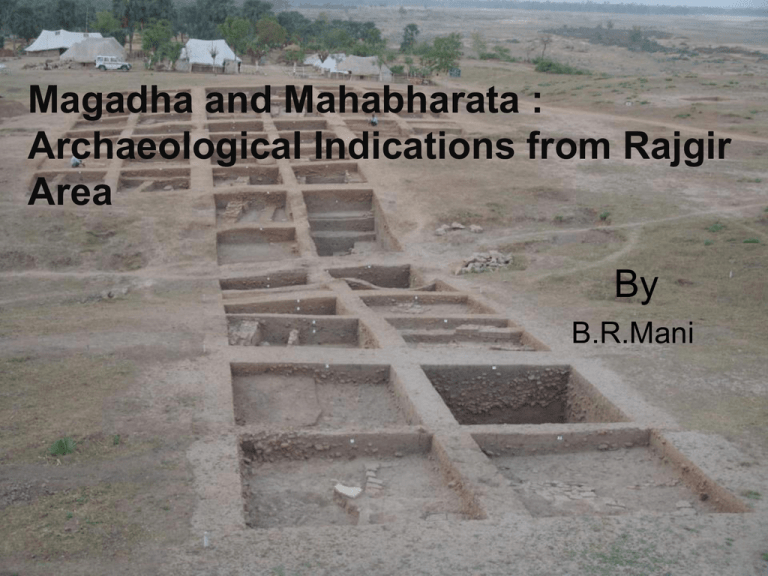Magadha and Mahabharata : Archaeological
advertisement

Magadha and Mahabharata : Archaeological Indications from Rajgir Area By B.R.Mani Magadha in Early Days • In his map prepared for understanding the extent of Magadha, Cunningham has shown its northern and southern areas adjoining the land of the Kikatas who were non-Vedic ancient tribes of the region. • Tradition takes back the political excellence of Magadha to the time of the Mahabharata War, sometimes in the middle of the second millennium BC, if not earlier when it was under the rule of Jarasandha. • Archaeological evidence from many of the excavated sites of the region suggest the beginning of culture in the neo-chalcolithic times. Evidence from Chirand, Taradih, Sonpur, Chechar, Maner, Oriup, Manjhi, Senuar etc. suggest cultural developments in Anga-Magadha area at least in the second millennium BC. • Recent excavations in and around Rajgir have further confirmed existence of the earlier culture, making a bridge between tradition and archaeology. Magadha in Early Days Rajgir (Ancient Girivraja or Rajagriha) • Rajgir was known in ancient times with different names, such as Vasumat in Ramayana , Barhadrathapura in Mahabharata and Puranas and Girivraja in Mahabharata, besides Kusagrapura in some Jaina and Buddhist texts. Girivraja was the most popular name of the capital city in Mahabharata. • The names of the surrounding hills are also found in Mahabharata, Buddhist and Jaina texts. • Some structures in Rajgir such as Jarasandha–ki-Baithak and Jarasandha-ka Akhara are still connected with the name of Jarasandha, the king of Magadha in the time of Mahabharata War. • Buddhaghosha, a Pali commentator mentions two fortified parts of city – inner and outer ( antarnagara and bahirnagara ), having 32 large and 64 smaller gates. The fortifications are still visible. • The capital city lost its status in the time of Udayin (c. 459-443 BC) when the capital was shifted to Pataliputra. Rajgir Rajgir Jarasandh ki Baithak(Size at surface 25m x 23.5m, Top 24m x 21.50m, maximum height 8.25m), Rajgir Jarasandh ka Akhara (dual ground), Rajgir The Tradition • A.D. Pusalkar, in his Book IV (Historical Traditions) in the R.C. Majumdar edited The Vedic Age (Bombay, 1971) has described The Krishna Period (c. 1950-1400 B.C.) and the Bharata War in C. 1400 B.C. • Barhadratha dynasty ruled over the kingdom of Magadha with its capital at Girivraja (Rajgir) at the time of the Bharata War and Mahabharata describes legends connected with the birth and also about the death of its ruler Jarasandha who was son of Brihadratha. • • The Storey The two wives of Brihadratha gave birth to two halves of a boy and horrified royal family threw them away. A female man-eating demon named Jara picked them up and put them together to carry them off. On their coming in contact a boy was formed and the father gave him the name of Jarasandha, because he had been put together by Jara. • Jarasandha became an ardent worshipper of Lord Siva and prevailed over many kings and married two of his daughters with Kansa, the maternal uncle of Krishna. He attacked Krisna 18 times but was often defeated. He had many kings in captivity who were freed when Krishna went to his capital along with Bhima and Arjuna and got him killed by Bhima. • The Tradition • Jarasandha’s son Sahadeva became an ally of the Pandavas and was killed in the war. • Somadhi became king of Girivraja, at the foot of which Rajagriha (modern Rajgir ) , the ancient capital of Magadha grew up. Ripunjaya, the 21st in descent from Somadhi was the last ruler of the dynasty, killed by his minister Pulika who installed his son Pradyota on the throne. • According to the Puranas, the dynasty of Pradyota ruled for five generations covering a period of 138 years and was supplanted by Sisunaga. Bimbisara (c. 543-491 BC)and his son Ajatasatru (c. 491459 BC), the contemporaries of Buddha and Mahavira were 5th and 6th kings of the new dynasty. • It is possible that many historical facts and genealogical details have been wrongly jumbled together and placed in false sequence. In spite of this, it is quite evident that there must have been more than 25 generation of rule if not of 33 generations between the Mahabharata War and the time of Buddha and Mahavira which could be placed towards the second half of the second millennium BC. Rajgir : The Cyclopean Wall • A. Ghosh says “ At a very early stage in the life of the city the natural defences were substantially re-inforced by a fortification consisting of a high rubble –wall running at the top of all the hills, with a circuit of about 25 miles and the natural gaps between the hills were utilised as gates in the fortification. Inside the valley were other defencive walls built in different periods…..” (AI, No.7). Cyclopean wall near southern gateway(Old Rajgir) • Attributing constructions to Jarasandha, it has been opined “Such Cyclopean fortification walls have been found in ancient Greece (Mycenaean city and Tiryns) and placed in the later half of 2nd millennium B.C. (1400-1300 B.C.).” (S.C.Saran in Purabharati, Delhi, 2006, Vol.1, p.27). Rajgir • Construction of buildings of new Rajagriha and its fortification belong to the time of Bimbisara and Ajatasatru as also indicated by literary texts. Rajgir Chariots’wheel mark/impression near Banganga Pass, Rajgir Sankh Lipi (Shell Script) near the spot of Chariots’ wheel mark/impression near Banganga Pass , Rajgir Rajgir Excavations : 1950 • A small scale excavation was carried out at Rajgir by A. Ghosh in 1950 ( Rajgir 1950, Ancient India, No.7, ASI,1951, pp.66-78). • The cultural sequence as mentioned by A. Ghosh is as below – Period I : earlier than the fifth century B.C. Period II : fifth century B.C. (or earlier) to second century B.C. Period III : first century B.C. Period IV : first century A.D. • Period I was characterised by about 1.20m deposit having rolled “rare sherds”, burnt earth and charcoal pieces. Period II with a deposit of about 2.40m having three phases is characterised by the presence of NBPW. • An interesting feature noticed in the limited excavation was the evidence of ten post-cremation burials, previously unknown. • The conventional date of NBPW believed by the excavator, needs revision in view of the large number of scientifically determined dates from many recent excavations and accordingly the chronological sequence could be pushed back to several centuries. Southern Gateway of New Rajgriha Rajgir 1950 New Evidence of Early Cultures from Rajgir Area • Habitational deposits from two of the recent excavatios in the Rajgir area by the Excavation Branch, Patna of the Archaeological Survey of India have indicated the beginning of culture in the area in the middle of the second millennium BC. • Both of these sites have yielded some sherds of Painted Grey Ware (PGW), generally associated with the Mahabharata. • These sites are – 1) Juafardih, near Nalanda (2006-07) 2) Ghorakatora, near Giryak in Rajgir (2007-08) Juafardih A potential Stupa Mound, with Pre-NBPW Remains in Nalanda excavated by ASI Excavations at Juafardih •Juaffardih at 2 km south-west of Nalanda has been excavated during 2006-2007 by the Excavation Branch, Patna (ASI) under S.C.Saran. •The mound as identified by the author as a stupa in 2005-06 and after excavations has revealed remains of a mud stupa of Mauryan period(c.3rd century BCE) which was constructed in the last phase of the habitation of Period II of the site, marked with the presence of NBPW and other related ceramics lying over the layers of chalcolithic habitational deposits. • The excavator has identified it with Kulika, the place of birth and nirvana of Mahamoggalana, desciple of Lord Buddha. • A rich deposit of 10.61m belonging to the Period II (NBPW Period) having three phases has 4 C14 dates , as 857 BC,1002 BC, 1562 BC and 1259 BC, comparable to early dates of NBPW from Ayodhya, Agiabir, Rajdhani, Gotihwa and Jhusi. •The single C14 date from the cultural deposit of PreNBPW (Chalcolithic Period) is 1354 BC which has been found to be consistent. Juafardih Excavations 2006-07 Ghorakatora, Near Giriyak •Ghorakatora (Lat.25 01’57”N; Long85 31’31”E) is located near Giriyak on the bank of river Panchane in district Nalanda . •It is located about 19 Km south-east of Nalanda . It is further located 8 Km east of Rajgir. • •The mound- It is a massive one with an area of 22.74 acres of land. •It measures about 800 m X 500 m. •The approximate height of the mound is 7 mtr. Recent findings from the excavations at Ghorakatora • The archaeology of Ghorakatora has pushed back the chronology of Rajgir and its neighborhood to the stage of emergence of the early farming as was done for Nalanda by the findings at Jufardih. • The site is located below the foothills of Giriyak, spread between the flood plain of Panchane and Goithawan. • The location of the site provides natural resources for metal and minerals and stone, besides games of wild animals and situation for agro-pastoral subsistence. • The excavation has reported following sequence: early farming stage of neolithic/chalcolithic nature; Iron age; NBPW (Mauryan); Sung, Kushan; Gupta and Post Gupta denoting assemblage of Pala period. • From the post Gupta levels a number of storage jars have been reported in situ suggesting surplus production of agricultural produce and their storage and marketing. Ghorakatora Previous Archaeological works •F. Buchanan (1811-12) for the first time noticed the mound . •During the survey he had found a good number of Hindu and Buddhist sculptures. •He also referred to about a small square fort with bastions at the corners , veneered with bricks. •Major Kittoe in 1847 visited the site and described this mound as a citadel which is parallelogram in shape. •Broadley in 1872 mentioned it ruins of a fort. • Alexander Cunningham in 1861-62 mentioned a small mud fort at the centre of the mound. He further noticed several sculpture at the northern end of the mound. One of which may be assignable to 11th century A.D. • John Marshall along with his team carried out archaeological investigations in 1905-06 in some areas of Rajgir and A. Ghosh in 1950, but Ghorakatora was not investigated by them. •K.K. Sharma in 1987 reported about NBPW, Grey ware, Black slipped ware, Red ware, Glazed ware. He also observed the remains of the brick structures having the brick jsize of 41x28x61 cms. Ghorakatora Recent Work: Excavations in 2007-08 Important finds are • Remains of burnt bricks structures • About a dozen of ring wells • Pottery– Black and Red Ware Black Slipped Ware NBPW Red ware Shapes include – bowls , lipped bowls, vases with narrow mouth, spouted vases and basing. • Antiquities – Terracotta beads of Areca nut shape and barrel shape. Terracotta bangle pieces, sling balls, fragments of rattle. Terracotta plaque of Sunga period. The excavation was conducted by P. K. Mishra, Superintending Archaeologist, ASI, Patna Circle and Excavation Branch –I • Trenches were laid out by following the principles of Horizontal excavation. • The mound was divided into grids, each measuring 10x10m. • Altogether 24 numbers of trenches were excavated. Tentative Chronology of the site Period I : Chalcolithic culture (c1500 B.C.-800 B.C.) Period II : NBPW Period (c800 B.C.-200 B.C.) Period III : Sunga – Kushana Period (c-200B.C.-300 AD) Period IV : Gupta & Post Gupta Period (300A.D. to 800A.D.) Period V : Pala Period (c800 A.D. to 1200 A.D.) Chalcolithic Ghorakatora Structure: • Period I representing 1.4m cultural deposit exposes remains of chalcolithic period resting on the natural soil. • The structure are found from this level are wattle and daub structure. The people of that age were living in huts made of reeds, frame and mud plaster over it. Finding of some burnt daubs revealed from excavation substantiates the facts. Pottery Period I (1500B.C.to 800B.C.)-Ceramic assemblage of chalcolithic period in this sites classified as : Black and Red ware Black ware Black slipped ware Red ware Black and Red ware pottery from excavations may be compared with that of Chirand (Dist. - Saran) and Sonpur (DistGaya). The fabric of this ware varies form coarse to fine variety. The types include dish-on- stand vases, bowls, dish, basin, lipped basin, storage jar, handi with carination on the shoulder, long necked jar, suspended jars and perforated basins. The important shapes are vases, bowls, dish, lid cum bowls etc. Deep bowl, basin and dish are the common types in B& R ware which belong to the Pre NBPW phase. Paintings have been observed in Red ware and Grey ware. The painted motifs. Some of them are treated with Red slip. The fabric ranges from coarse to medium. The the types include vases with narrow mouth vases with wide mouth, carrinated handis, bowls, Ramps, lids, basins and storage Jars. Antiquities Polished stone celts. Fragments of stone Quern Pestle Sling ball Terracotta beads Hop scotches Wheel Bone points Fragments of copper Antimony rod Ghorakatora Section facing east A4 x IV Brick wall with storage jars, B2 x I Ghorakatora Excavations Ghorakatora Stone celts (chalcolithic period) Grains and charcoal recourse recovered through floatation process (chalcolithic period) Ghorakatora Burnt clay showing evidence of wattle & daub structures, Chalcolotic period Kauri Chalcolithic Ghorakatora NBPW, Red Ware, Blackand -red ware sherds Chalcolithic Ghorakatora Chalcolithic Ghorakatora Storage jars, chalcolothic period Terracotta objects, chalcolothic period Ghorakatora Ghorakatora Historical Ghorakatora Historical Ghorakatora Ghorakatora To Sum up..... • The event of Mahabharata War could be placed in the second half of the second millennium BC as indicated by genealogical calculations as well as archaeological evidence from Mahabharata related sites and distribution of certain ceramics including Painted Grey Ware. • The event is tentatively put around 1400 BC although another view takes it back to about 3102 BC as per tradition of Yudhishthira era. • Girivraja or Rajagriha (modern Rajgir) is mentioned as capital of Magadha and ruled by Jarasandha at the time of the great war. • Archaeological evidence from recent excavations in and around Rajgir and other parts of Anga-Magadha region confirm cultural activities in the middle of the second millennium BC and possibly even earlier. And finally..... Detailed study in future at Rajgir is required to understand – • The period of Cyclopean Wall and other fortifications and structures • The period of chariots’ wheel marks • Tradition of female demons – Jara of Mahabharata and Hariti of the time of the Buddha • Tradition of naming of kings such as Brihadratha (the first of the Barhadratha and the last of the Maurya dynasty • Tradition of special archaeological evidence of perforated and curiously made multi-spouted ritualistic jars at Maniyarmath and post-cremation burials Nature of earlier settlements etc. •






